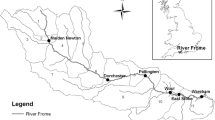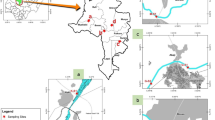Abstract
This study investigated the interactions of submersed plants with environmental factors using structural equation modeling (SEM) and evaluated the effect strength of respective factors in an aquatic ecosystem using a data set collected at a fourth order stream in Japan. A model that simultaneously examines the relative importance of factors of the system has developed. The investigated factors included plant biomass (Biomass) of submersed macrophytes (Potamogeton malaianus and Potamogeton oxyphyllus) and other environmental factors, i.e. water velocity and water depth (Hydraulic), pore water nitrogen (TNL), pore water phosphorus (TPL), sediment organic matter (Organic) and sediment particle size (Texture). The estimated model showed that the Biomass was negatively correlated with Hydraulic but positively correlated with Organic whilst TNL and TPL affected the Biomass with almost equal strength. The effects caused by Hydraulic to Texture were greater than the ones caused by Biomass. At the narrow ranges of water velocity (0–7 cm s−1) and shallow depth (0–35 cm), the effect of wash-away of Organic by Hydraulic were smaller than the retention effect of Organic by Biomass. These results provide more insights into interactions of the submersed macrophytes with environmental factors.



Similar content being viewed by others
References
APHA, 1995. Standard Methods for the Examination of Water and Wastewater. 19th edn. American Public Health Association, Water Works Association and Water Environment Federation, Washington, DC, USA.
Asaeda, T., N. T. Hung, J. Manatunge & T. Fujino, 2004. The effects of flowing water and organic matter on the distribution of submersed macrophytes. Journal of Freshwater Ecology 19(2): 401–405.
Barko, J. W. & R. M. Smart, 1986. Sediment-related mechanisms of growth limitation in submersed macrophytes. Ecology 67: 1328–1340.
Barko, J. W. & R. M. Smart, 1981. Sediment-base nutrition of submersed macrophytes. Aquatic Botany 10: 339–352.
Best, M. D. & K. E. Mantai, 1978. Growth of Myriophyllum: sediment or lake water as the source of nitrogen and phosphorus. Ecology 59: 1075–1080.
Biggs, B. J. F., 1996. Hydraulic habitat of plants in streams. Regulated River Research & Management 12: 131–144.
Carignan, R. F. & J. Kalff, 1980. Phosphorus sources for aquatic weeds: water or sediment? Science 207: 987–989.
Carr, G. M. & P. A. Chambers, 1998. Macrophyte growth and sediment phosphorus and nitrogen in a Canadian prairie river. Freshwater Biology 39: 525–536.
Chambers, P. A., E. E. Prepas, H. R. Hamilton & M. L. Bothwell, 1991. Current velocity and its effects on aquatic macrophytes in flowing waters. Ecological Applications 1: 249–257.
Chambers, P. A., E. E. Prepas, M. L. Bothwell & H. R. Hamilton, 1989. Roots versus shoots in nutrient uptake by aquatic macrophytes in flowing water. Canadian Journal of Fisheries and Aquatic Sciences 46: 435–439.
Chambers, P. A., 1987. Light and nutrients in the control of aquatic plant community structure. II. In situ observations. Journal of Ecology 75: 621–628.
Champion, P. D. & C. C. Tanner, 2000. Seasonality of macrophytes and interaction with flow in a New Zealand lowland stream. Hydorbiologia 441: 1–12.
Feijoó, C. S., F. R. Momo1, C. A. Bonetto & M. T. Nuncia, 1996. Factors influencing biomass and nutrient content of the submersed macrophyte Egeria densa Planch. in a pampasic stream. Hydrobiologia 341(1): 21–26.
Flynn, N .J., D.L. Snook, A. J. Wade & H. P. Jarvie, 2002. Macrophyte and periphyton dynamics in a UK Cretaceous chalk stream: the river Kennet, a tributary of the Thames. The Science of the Total Environment 282–283: 143–157.
Gantes, H. P. & A. S. Caro, 2001. Environmental heterogeneity and spatial distribution of macrophytes in plain streams. Aquatic Botany 70: 225–236.
Gough, L. & J. B. Grace, 1999. Effects of environmental change on plant species density: comparing predictions with experiments. Ecology 80(3): 882–890.
Grace, J. B. & B. H. Pugesek, 1997. A structural equation model of plant species richness and its application to a coastal wetland. The American Naturalist 149(3): 436–460.
Grace, J. B., A. Larry & A. Charles, 2000. Factors associated with plant species richness in a coastal tall grass prairie. Journal of Vegetation Science 11: 443–452.
Haslam, S. L., 1978. River Plants: the Macrophytic Vegetation of Watercourses. Cambridge University Press, Cambridge, UK.
Hayduk, L. A., 1987. Structural Equation Modeling with LISREL: Essentials and Advances. John Hopkins University Press, Baltimore, Maryland, USA.
Hoyle, R. H. & T. S. Gregory, 1994. Formulating research hypothesis as structural equation models: a conceptual overview. Journal of Consulting and Clinical Psychology 62(3): 429–440.
Hoyle, R. H., 1995. Structural Equation Modeling Concepts, Issues, and Applications. SAGE Publications, Thousand Oaks, California.
Kelloway E. K., 1998. Using LISREL for Structural Equation Modeling, A Researcher’s Guide. SAGE Publications, International Educational and Professional Publisher.
Kline, R. B., 1998: Principles and Practice of Structural Equation Modeling. The Guilford Press, New York.
Johnson, M. L. & D. G. Huggins & F. DeNoyelles Jr., 1991. Ecosystem modeling with LISREL: a new approach for measuring direct and indirect effects. Ecological Applications 4:383–398.
Joreskog, K. G. & D. Sorbom, 1996. LISREL 8 User’s Reference Guide. Scientific Software International, Chicago, Illinois, USA.
Joreskog, K. G., 1973. A general method for estimating a linear structural equation system. In Goldberger, A. S. & O. D. Duncan (eds), Structural Equation Models in the Social Sciences. Seminar Press, New York, 85–112.
Joreskog, K. G., 1974. Analyzing psychological data by structural analysis of covariance matrices. In Atkinson, R. C., D. H. Krantz, R. D. Luce & P. Suppes (eds), Contemporary Developments in Mathematical Psychology, Vol. II. W.J. Freeman, San Francisco, 1–56.
Losee, R. F. & R. G. Wetzel, 1993. Littoral flow rates within and around submerged macrophyte communities. Freshwater Biology 29: 7–17.
Madsen, J. D. & A. S. Adam, 1989. The distribution of submersed aquatic macrophyte biomass in a eutrophic stream, Badfish Creek: the effect of environment. Hydrobiologia 171: 111–119.
Madsen, J. D., 1999: Point intercept and line intercept methods for aquatic plant management. APCRP Technical Notes Collection (TN APCRP-M1-02). U.S. Army Engineer Research and Development Center, Vicksburg, MS.
Madsen, J. D., P. A. Chambers, W. F. James, E. W. Koch & D. F. Westlake, 2001. The interaction between water movement, sediment dynamics and submersed macrophytes. Hydrobiologia 444: 71–84.
Madsen, T. V., H. O. Enevoldsen & T. B. Jorgensen, 1993. Effect of water velocity on photosynthesis and dark respiration in submersed stream macrophytes. Plant, Cell and Environment 16: 317–322.
Madsen, T. V. & N. Cedegreen, 2002. Sources of nutrient to rooted submersed macrophytes growing in a nutrient-rich stream. Freshwater Biology 47: 283–291.
Nilsson, C., 1987. Distribution of stream-edge vegetation along a gradient of current velocity. Journal of Ecology 75: 513–522.
Power, P., 1996. Effect of current and substrate composition on growth of Texas wildrice (Zizania texana). Aquatic Botany 55: 199–204.
Pugesek, B. H. & A. Tomer, 1996. The Bumpus house sparrow data: a reanalysis using structural equation models. Evolutionary Ecology 10: 387–404.
Riis, T. & B. J. F. Biigs, 2001. Distribution of macrophytes in New Zealand streams and lakes in relation to disturbance frequency and resource supply—a synthesis conceptual model. New Zealand Journal of Marine and Freshwater Research 35: 255–267.
Riis, T. & B. J. F. Biigs, 2003. Hydrologic and hydraulic control of macrophyte establishment and performence in streams. Limnology Oceanography 48(4):1488–1497.
Rubio, D. M. & D. F. Gillespie, 1995. Problems with errors in structural equation models. Structural Equation Modeling 2(4): 367–378.
Sand-Jensen, K. & J. R. Mebus, 1996. Fine-scale patterns of water velocity within macrophyte patches in streams. Oikos 76: 169–180.
Sand-Jensen, K., 1998. Influence of submerged macrophytes on sediment composition and near bed flow in lowland streams. Freshwater Biology 39: 663–679.
Sand-Jensen, K., E. Jeppesen, K. Nielsen, L. V. D. Bijl, L. Hjermind, L. W. Nielsen & T. M. Iversen, 1989. Growth of macrophytes and ecosystem consequences in a lowland Danish stream. Freshwater Biology 22: 15–32.
Stanley, A. N., 1994. Factors influencing the distribution of Eurasian Watermilfoil (Myriophyllum spicatum L.) biomass in lake Wingra, Wisconsin. Journal of Freshwater Ecology 9(2): 145–151.
Weisner, S. E. B., J. A. Strand & H. Sandsten, 1997. Mechanisms regulating abundance of submerged vegetation in shallow eutrophic lakes. Oecologia 109: 592–599.
Westlake, D. F., 1967. Some effects of low velocity currents on the metabolism of aquatic macrophytes. Journal of Experimental Botany 18: 187–205.
Wiegleb, G. & Y. Kadono, 1989. Growth and development of Potamogeton malaianus in SW Japan. Nordic Journal of Botany 9(2): 167–178.
Acknowledgements
We would like to express our gratefulness to Dr. John D. Madsen (Mississippi State University, Mississippi State, USA) for the constructive discussion during the field investigation, Professor G. Wiegleb (Cottbus University, Germany) for the beneficial discussion while drafting the paper. We also would like to express our sincere thanks to Takuya Yamashita, Lalith Rajapakse and other members of the Engineering Ecology Laboratory of Saitama University for their assistance in the field and laboratory. Last but not least, we must admit that the comments and suggestions of the editor and reviewers of the journal have greatly contributed to the improvement and dissemination of this manuscript. This research was supported by grants from the Foundation of River and Watershed Management, and the Ministry of Education, Science, Culture and Sports of Japan.
Author information
Authors and Affiliations
Corresponding author
Additional information
Handling editor: K. Martens
Rights and permissions
About this article
Cite this article
Hung, N.T., Asaeda, T. & Manatunge, J. Modeling interactions of submersed plant biomass and environmental factors in a stream using structural equation modeling. Hydrobiologia 583, 183–193 (2007). https://doi.org/10.1007/s10750-006-0526-0
Received:
Revised:
Accepted:
Published:
Issue Date:
DOI: https://doi.org/10.1007/s10750-006-0526-0




